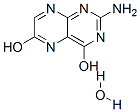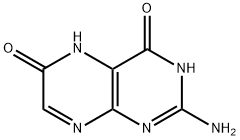XANTHOPTERIN MONOHYDRATE
- CAS NO.:5979-01-1
- Empirical Formula: C6H7N5O3
- Molecular Weight: 197.15
- MDL number: MFCD00151242
- EINECS: 611-886-9
- SAFETY DATA SHEET (SDS)
- Update Date: 2024-11-18 17:01:59

What is XANTHOPTERIN MONOHYDRATE?
Chemical properties
yellow to orange crystalline powder
The Uses of XANTHOPTERIN MONOHYDRATE
Biochemical research.
The Uses of XANTHOPTERIN MONOHYDRATE
Xanthopterin (cas# 5979-01-1) is useful as a crystal nucleation of vinylidene chloride polymers.
What are the applications of Application
Xanthopterin is a pigment first discovered in butterfly wings
Definition
Pigment found in the wings of butterflies; can be converted by yeast into folic acid.
Purification Methods
Purification is as for isoxanthopterin (see “Heterocyclic Compounds”, Chapter 4). It is crystallised by acidifying a hot ammoniacal solution with formic acid, and collecting the crystals by centrifugation followed by washing with EtOH, ether and drying at 100o in vacuo. Its RF values on paper chromatography are 0.15 (n-PrOH, 1% aqueous NH3, 2:1), 0.36 (n-BuOH/AcOH/H2O, 4:1:1) and 0.47 (3% aqueous NH3). [Inoue & Perrin J Chem Soc 260 1962, Inoue Tetrahedron 20 243 1964, see also Blakley Biochemistry of Folic Acid and Related Pteridines North Holland Publ Co, Amsterdam 1969, Beilstein 26 II 313, 26 III/IV 4000.]
Properties of XANTHOPTERIN MONOHYDRATE
| Melting point: | >300 °C(lit.) |
| storage temp. | Hygroscopic, -20°C Freezer, Under inert atmosphere |
| solubility | DMSO (Slightly), Methanol (Slightly), Water (Slightly) |
| form | Solid |
| pka | 6.59(at 20℃) |
| color | Yellow to Dark Yellow |
| Sensitive | Air Sensitive |
| Merck | 14,10064 |
| Stability: | Hygroscopic |
| CAS DataBase Reference | 5979-01-1(CAS DataBase Reference) |
Safety information for XANTHOPTERIN MONOHYDRATE
| Signal word | Warning |
| Pictogram(s) |
 Exclamation Mark Irritant GHS07 |
| GHS Hazard Statements |
H302:Acute toxicity,oral H315:Skin corrosion/irritation H320:Serious eye damage/eye irritation H335:Specific target organ toxicity, single exposure;Respiratory tract irritation |
| Precautionary Statement Codes |
P261:Avoid breathing dust/fume/gas/mist/vapours/spray. P280:Wear protective gloves/protective clothing/eye protection/face protection. P301+P312:IF SWALLOWED: call a POISON CENTER or doctor/physician IF you feel unwell. P302+P352:IF ON SKIN: wash with plenty of soap and water. P305+P351+P338:IF IN EYES: Rinse cautiously with water for several minutes. Remove contact lenses, if present and easy to do. Continuerinsing. |
Computed Descriptors for XANTHOPTERIN MONOHYDRATE
New Products
4-AMINO-TETRAHYDRO-PYRAN-4-CARBOXYLIC ACID HCL 4-(Dimethylamino)tetrahydro-2H-pyran-4-carbonitrile 4-AMINO-TETRAHYDRO-PYRAN-4-CARBOXYLIC ACID 4-Aminotetrahydropyran-4-carbonitrile Hydrochloride (R)-3-Aminobutanenitrile Hydrochloride 5-Bromo-2-nitropyridine Nimesulide BP Aceclofenac IP/BP/EP Diclofenac Sodium IP/BP/EP/USP Mefenamic Acid IP/BP/EP/USP Ornidazole IP Diclofenac Potassium 3-Bromopyrazole (3aR,4R,5R,6aS)-hexahydro-5-Triethyl silyloxy-4-((E)-3-oxo-5-phenylpent-1- enyl)cyclopenta[b]furan-2-one. 1-Chlorocarbonyl-4-piperidinopiperidine 1-Bromo-4-phenyl-2-Butanone 4-Amino-2-fluoro-N-methylbenzamide 1,1'-Carbonyldiimidazole SODIUM AAS SOLUTION ZINC AAS SOLUTION BUFFER SOLUTION PH 10.0(BORATE) GOOCH CRUCIBLE SINTERED AQUANIL 5 BERYLLIUM AAS SOLUTIONRelated products of tetrahydrofuran
You may like
-
![Dimethyl [2-oxo-3-[3-(trifluoromethyl)phenoxy]propyl]phosphonate 99%](https://img.chemicalbook.in//Content/image/CP5.jpg) Dimethyl [2-oxo-3-[3-(trifluoromethyl)phenoxy]propyl]phosphonate 99%View Details
Dimethyl [2-oxo-3-[3-(trifluoromethyl)phenoxy]propyl]phosphonate 99%View Details
54094-19-8 -
 85-81-4 99%View Details
85-81-4 99%View Details
85-81-4 -
 Cyclopentane carboxxylic acid 3400-45-1 99%View Details
Cyclopentane carboxxylic acid 3400-45-1 99%View Details
3400-45-1 -
![208111-98-2 (3aR,4R,5R,6aS)-5-(Benzoyloxy)hexahydro-4-[(1E)-3-oxo-4-[3-(trifluoromethyl)phenoxy]-1-buten- 1-yl]-2H-cyclopenta[b]furan-2-one 99%](https://img.chemicalbook.in//Content/image/CP5.jpg) 208111-98-2 (3aR,4R,5R,6aS)-5-(Benzoyloxy)hexahydro-4-[(1E)-3-oxo-4-[3-(trifluoromethyl)phenoxy]-1-buten- 1-yl]-2H-cyclopenta[b]furan-2-one 99%View Details
208111-98-2 (3aR,4R,5R,6aS)-5-(Benzoyloxy)hexahydro-4-[(1E)-3-oxo-4-[3-(trifluoromethyl)phenoxy]-1-buten- 1-yl]-2H-cyclopenta[b]furan-2-one 99%View Details
208111-98-2 -
 2033-24-1 99%View Details
2033-24-1 99%View Details
2033-24-1 -
 Meldrums acid 2033-24-1 99%View Details
Meldrums acid 2033-24-1 99%View Details
2033-24-1 -
 Cyaclopentane carboxylic acid 99%View Details
Cyaclopentane carboxylic acid 99%View Details
3400-45-1 -
 2-Aminopyridine 504-29-0 99%View Details
2-Aminopyridine 504-29-0 99%View Details
504-29-0


